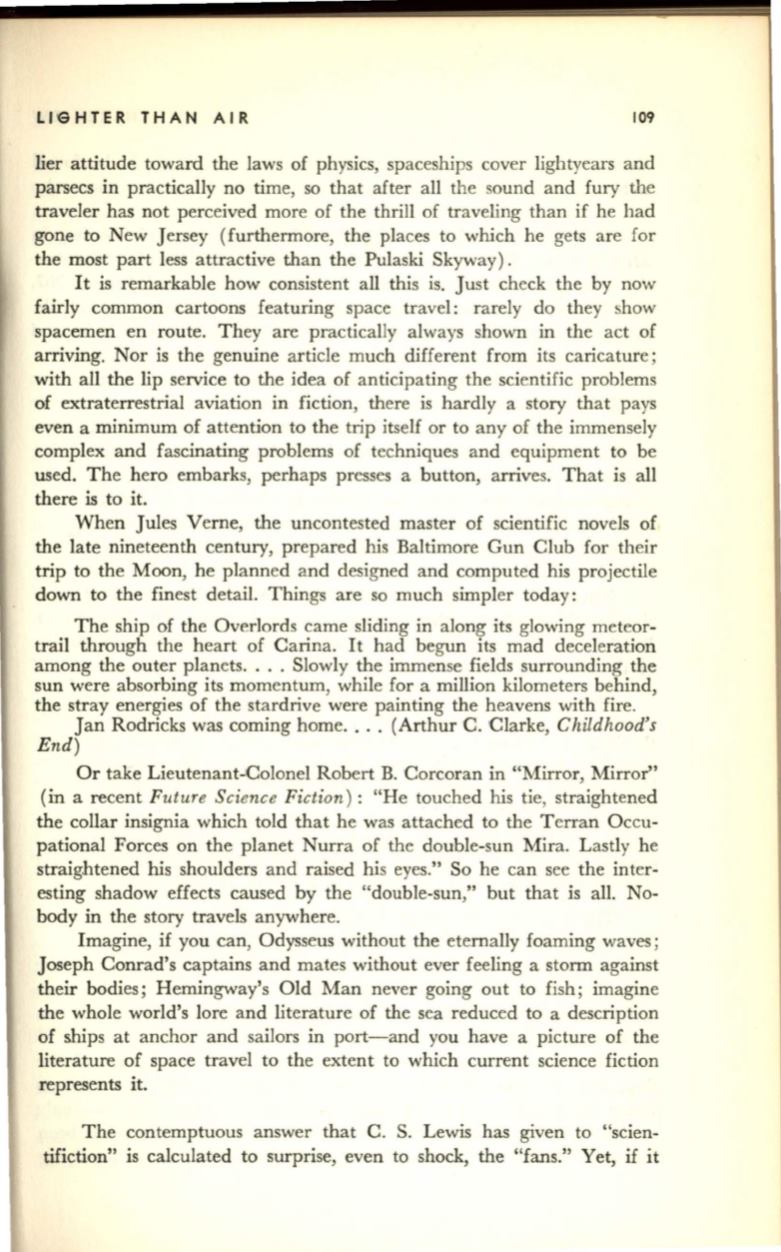
LIGHTER THAN
AIR
109
lier attitude toward the laws of physics, spaceships cover lightyears and
parsecs in practically no time, so that after all the sound and fury the
traveler has not perceived more of the thrill of traveling than if he had
gone to New Jersey (furthermore, the places to which he gets are for
the most part less attractive than the Pulaski Skyway).
It is remarkable how consistent all this is. Just check the by now
fairly common cartoons featuring space travel: rarely do they show
spacemen en route. They are practically always shown in the act of
arriving. Nor is the genuine article much different from its caricature;
with all the lip service to the idea of anticipating the scientific problems
of extraterrestrial aviation in fiction, there is hardly a story that pays
even a minimum of attention to the trip itself or to any of the immensely
complex and fascinating problems of techniques and equipment to be
used. The hero embarks, perhaps presses a button, arrives. That is all
there is to it.
When Jules Verne, the uncontested master of scientific novels of
the late nineteenth century, prepared his Baltimore Gun Club for their
trip to the Moon, he planned and designed and computed his projectile
down to the finest detail. Things are so much simpler today:
The ship of the Overlords came sliding in along its glowing meteor–
trail through the heart of Carina. It had begun its mad deceleration
among the outer planets.... Slowly the immense fields surrounding the
sun were absorbing its momentum, while for a million kilometers behind,
the stray energies of the stardrive were painting the heavens with fire.
Jan Rodricks was coming home... . (Arthur C. Clarke,
Childhood's
End)
Or take Lieutenant-Colonel Robert
B.
Corcoran in "Mirror, Mirror"
(in a recent
Future Science Fiction )
: "He touched his tie, straightened
the collar insignia which told that he was attached to the Terran Occu–
pational Forces on the planet Nurra of the double-sun Mira. Lastly he
straightened his shoulders and raised his eyes." So he can see the inter–
esting shadow effects caused by the "double-sun," but that is all. No–
body in the story travels anywhere.
Imagine, if you can, Odysseus without the eternally foaming waves;
Joseph Conrad's captains and mates without ever feeling a storm against
their bodies; Hemingway's Old Man never going out to fish; imagine
the whole world's lore and literature of the sea reduced to a description
of ships at anchor and sailors in port-and you have a picture of the
literature of space travel to the extent to which current science fiction
represents it.
The contemptuous answer that C. S. Lewis has given to "scien–
tifiction" is calculated to surprise, even to shock, the "fans." Yet, if
it


